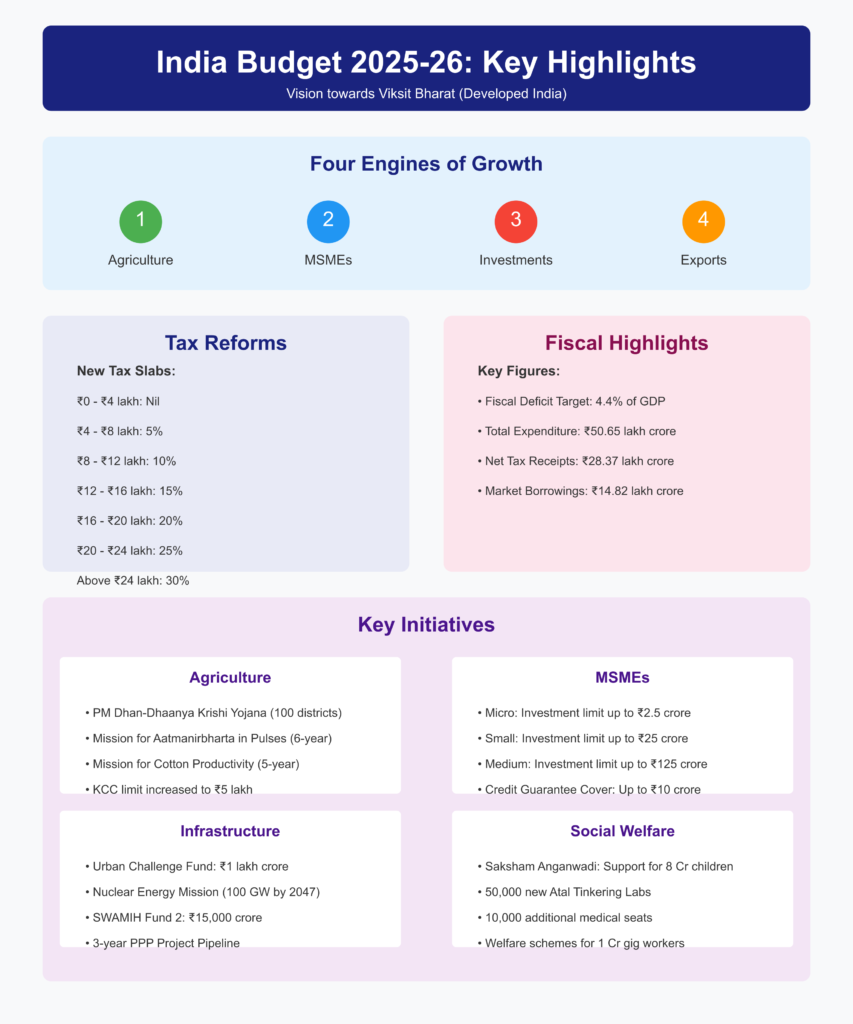The Union Budget 2025-26, presented by Finance Minister Nirmala Sitharaman on February 1, 2025, marks a significant milestone in India’s economic trajectory. Positioned as a roadmap to propel India towards “Viksit Bharat” (Developed India), this budget emphasizes inclusivity, fiscal prudence, and strategic investments in key sectors. Below, we provide an in-depth analysis of the budget’s highlights, sectoral insights, fiscal implications, and its anticipated impact on India’s economic landscape.
1. Overview of the Union Budget Theme
The Union Budget 2025-26, revolves around four primary engines of growth: Agriculture, MSMEs (Micro, Small, and Medium Enterprises), Investments, and Exports, with Reforms as the fuel driving these sectors. The overarching goal is to achieve balanced regional development, uplift household sentiments, and enhance the spending power of India’s burgeoning middle class.
Key focus areas include:
- Garib (Poor): Targeted welfare measures.
- Youth: Employment and skill development initiatives.
- Annadata (Farmers): Agricultural reforms and support.
- Nari (Women): Empowerment and financial inclusion programs.
2. Tax Reforms: Relief for the Middle Class
One of the most anticipated aspects of the The Union Budget 2025-26, is the significant relief for middle-class taxpayers. The non-taxable income threshold has been raised from ₹7 lakh to ₹12 lakh per annum, providing substantial relief to salaried individuals.
Revised Tax Slabs:
- 0 – ₹4 lakh: Nil
- ₹4 – 8 lakh: 5%
- ₹8 – 12 lakh: 10%
- ₹12 – 16 lakh: 15%
- ₹16 – 20 lakh: 20%
- ₹20 – 24 lakh: 25%
- Above ₹24 lakh: 30%
The new structure is expected to boost household consumption, savings, and investments, aligning with the government’s vision of stimulating economic growth through increased domestic demand.
Fiscal Implications:
- Revenue Impact: The government anticipates a revenue loss of ₹1 lakh crore in direct taxes due to these reforms. However, this is expected to be offset by increased economic activity and consumption.
3. Fiscal Consolidation and Deficit Management
Despite the tax relief measures, the government remains committed to fiscal prudence. The fiscal deficit target for 2025-26 is set at 4.4% of GDP, down from a revised 4.8% for the current fiscal year.
Key Figures:
- Total Expenditure: ₹50.65 lakh crore
- Net Tax Receipts: ₹28.37 lakh crore
- Market Borrowings: ₹14.82 lakh crore
The fiscal consolidation roadmap aims to ensure that the Central Government’s debt remains on a declining trajectory as a percentage of GDP over the next six years.
4. Sectoral Highlights and Strategic Initiatives
A. Agriculture: Strengthening the Backbone of the Economy
Agriculture remains a cornerstone of the Indian economy, and the The Union Budget 2025-26, outlines several initiatives to boost productivity and ensure farmers’ welfare.
- Prime Minister Dhan-Dhaanya Krishi Yojana: Targeting 100 districts to enhance productivity and promote sustainable farming practices.
- Mission for Aatmanirbharta in Pulses: A 6-year mission focusing on Tur, Urad, and Masoor, aiming for self-sufficiency in pulse production.
- Mission for Cotton Productivity: A 5-year initiative to enhance cotton yield and sustainability, promoting extra-long staple cotton varieties.
- Enhanced Credit through KCC: The loan limit under the Kisan Credit Card scheme has been raised from ₹3 lakh to ₹5 lakh.
Impact: These measures are expected to benefit over 1.7 crore farmers, improve rural incomes, and position India as a global agricultural powerhouse.
B. MSMEs: Catalysts of Economic Growth
MSMEs are the second engine of growth, and the budget introduces several initiatives to bolster this sector:
- Revision of MSME Classification: Enhanced investment and turnover limits to facilitate growth and scalability.
- Micro Enterprises: Investment limit raised from ₹1 crore to ₹2.5 crore.
- Small Enterprises: From ₹10 crore to ₹25 crore.
- Medium Enterprises: From ₹50 crore to ₹125 crore.
- Credit Support:
- Credit Guarantee Cover: Increased for Micro and Small Enterprises from ₹5 crore to ₹10 crore.
- Customized Credit Cards: Introduced with a ₹5 lakh limit for micro enterprises.
- Support for First-Time Entrepreneurs: A new scheme offering term loans up to ₹2 crore for 5 lakh women, SC, and ST entrepreneurs over the next five years.
Impact: These measures are expected to generate employment for 7.5 crore people and contribute to 45% of India’s exports.
C. Investments: Fueling Economic Expansion
Investment in infrastructure and innovation forms the third pillar of the budget.
- Public-Private Partnerships (PPP): Ministries to roll out a 3-year pipeline of PPP projects.
- Urban Challenge Fund: ₹1 lakh crore allocated for urban redevelopment and infrastructure.
- Nuclear Energy Mission for Viksit Bharat: Aiming for 100 GW of nuclear energy capacity by 2047.
- SWAMIH Fund 2: ₹15,000 crore allocated for completing 1 lakh housing units, aiding middle-class homebuyers.
Impact: These initiatives are set to enhance infrastructure, drive economic growth, and create a sustainable energy future.
D. Exports: Expanding Global Footprints
The fourth engine focuses on strengthening India’s position in global markets.
- Export Promotion Mission: Sectoral and ministerial targets to boost exports.
- BharatTradeNet: A unified platform for trade documentation and financing, streamlining international trade.
- Support for Global Supply Chain Integration: Identifying key sectors for integration into global supply chains, particularly in electronics and high-tech industries.
Impact: These measures aim to diversify India’s export base, enhance competitiveness, and solidify the country’s position in global trade.
5. Financial Sector Reforms
- FDI in Insurance: The foreign direct investment limit in the insurance sector has been raised from 74% to 100%, encouraging deeper market penetration and increased competition.
- Regulatory Reforms: A High-Level Committee for Regulatory Reforms will review and streamline non-financial sector regulations to enhance the ease of doing business.
- KYC Simplification: A revamped Central KYC Registry will be rolled out in 2025, simplifying compliance processes.
6. Social Welfare and Human Capital Development
- Saksham Anganwadi and Poshan 2.0: Enhanced nutritional support for over 8 crore children and 1 crore pregnant women.
- Atal Tinkering Labs: 50,000 labs to be established in government schools to foster innovation.
- Expansion of Medical Education: 10,000 additional medical seats to be added in the coming year.
- Welfare for Gig Workers: Registration on the e-Shram portal and healthcare under PM Jan Arogya Yojana for 1 crore gig workers.
7. FAQs on Budget 2025-26
Q1: How does the new tax regime affect the middle class?
The new tax regime significantly benefits the middle class by raising the non-taxable income threshold to ₹12 lakh, reducing the tax burden, and increasing disposable income.
Q2: What measures are introduced for farmers?
The budget introduces several schemes like the Prime Minister Dhan-Dhaanya Krishi Yojana, Mission for Aatmanirbharta in Pulses, and enhanced credit through KCC to support farmers.
Q3: How will the budget impact MSMEs?
Revised classification criteria, enhanced credit guarantees, and support for first-time entrepreneurs will help MSMEs scale operations and contribute more significantly to the economy.
Q4: What are the fiscal deficit targets for 2025-26?
The fiscal deficit target is set at 4.4% of GDP, reflecting the government’s commitment to fiscal consolidation while supporting growth.
Q5: What reforms are introduced in the financial sector?
The budget increases the FDI limit in insurance to 100%, introduces regulatory reforms, and simplifies KYC processes to enhance financial sector efficiency.
Conclusion
The Union Budget 2025-26 represents a balanced approach to fostering economic growth while maintaining fiscal discipline. By focusing on tax relief for the middle class, strategic investments in key sectors, and comprehensive reforms, the budget sets the stage for India’s continued ascent as a global economic powerhouse. As the country moves towards the vision of “Viksit Bharat,” these initiatives promise to deliver inclusive growth, enhanced competitiveness, and sustained prosperity for all.

You might also be interested in: Budget Session 2025: Key Announcements, Economic Survey Insights & Future Outlook



